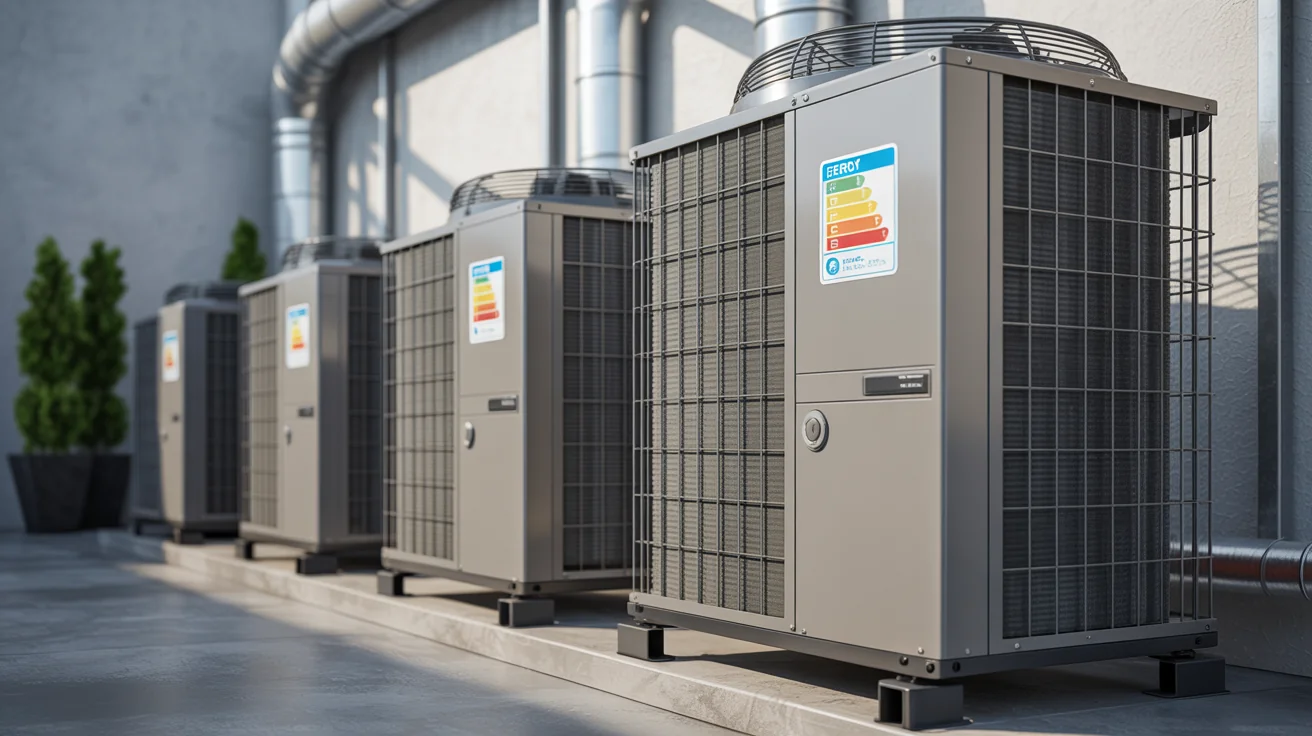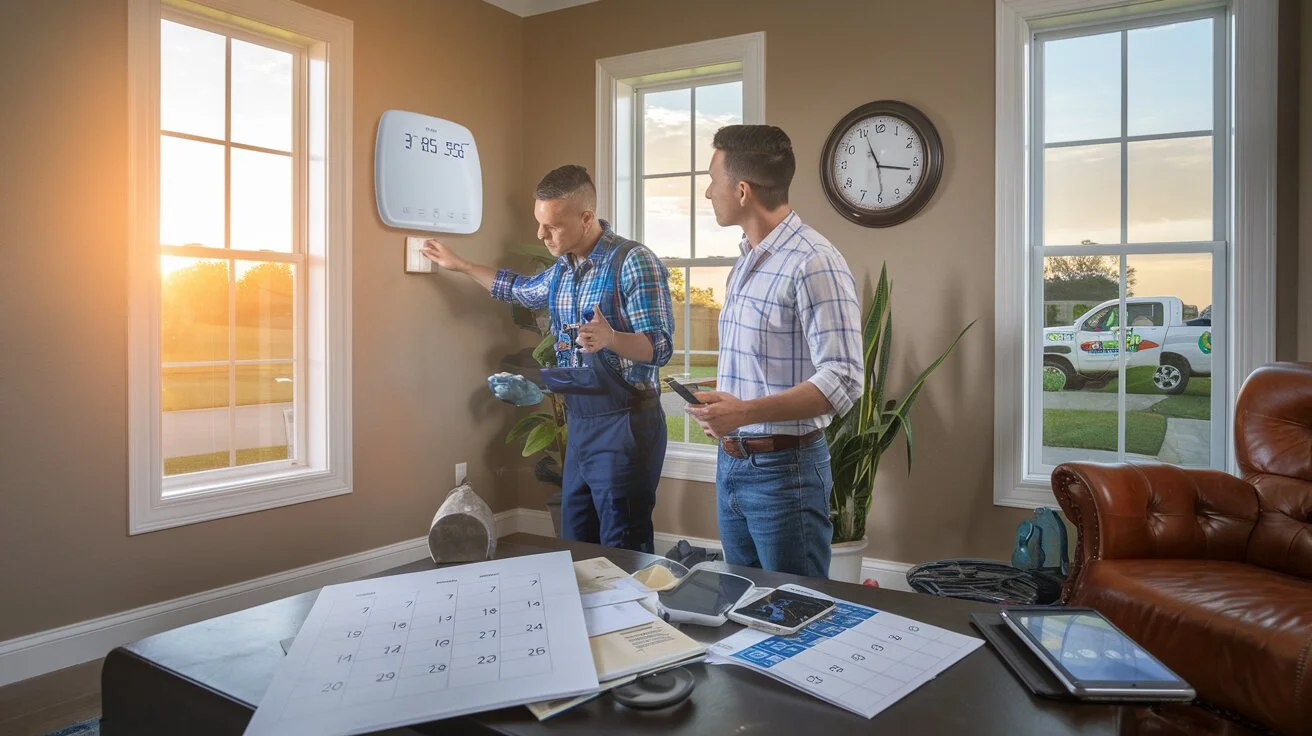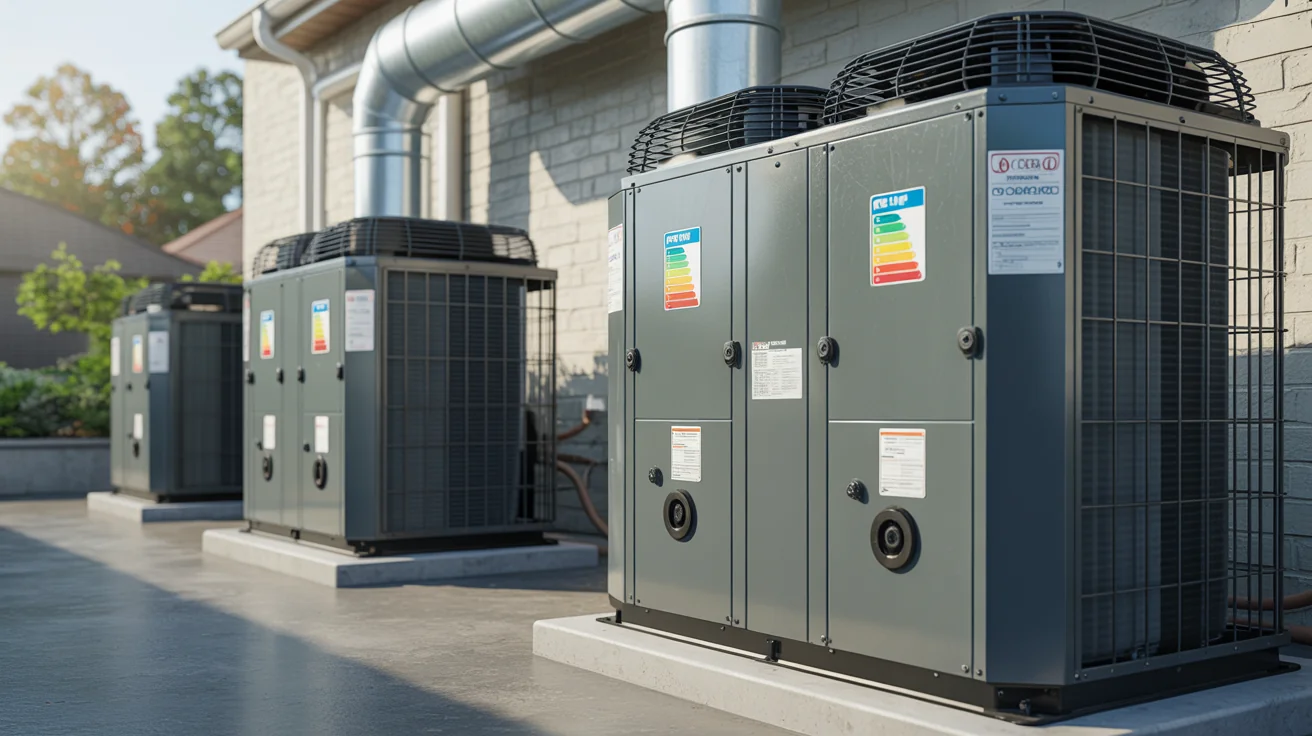Seasonal HVAC Energy Saving Strategies: North Texas Year-Round Efficiency Guide
Comprehensive year-round HVAC energy saving guide for North Texas. Season-specific strategies to reduce energy costs, improve comfort, and maximize system efficiency across all weather conditions.

- The Utility Bill That Made a Grown Man Cry
- Why Your Electric Company is Getting Rich Off Texas Weather
- Spring Energy Optimization Strategies (March-May)
- Summer Energy Survival Strategies (June-August)
- Fall Transition Energy Strategies (September-November)
- Winter Energy Efficiency Strategies (December-February)
- Year-Round Energy Efficiency Technologies
- Regional Energy Saving Considerations
+ 7 more sections below...
- The Utility Bill That Made a Grown Man Cry
- Why Your Electric Company is Getting Rich Off Texas Weather
- Spring Energy Optimization Strategies (March-May)
- Summer Energy Survival Strategies (June-August)
- Fall Transition Energy Strategies (September-November)
- Winter Energy Efficiency Strategies (December-February)
- Year-Round Energy Efficiency Technologies
- Regional Energy Saving Considerations
+ 7 more sections below...
The Utility Bill That Made a Grown Man Cry
Last August, a customer in Frisco called me about his electric bill. Not his HVAC system - his electric bill. When he opened it, he actually started crying.
$847 for one month.
Now, this wasn’t some mansion. Standard two-story, 2,800 square feet. But his AC had been running nonstop for six weeks of 105-degree heat, and he’d made every energy mistake possible.
North Texas homeowners spend 40-60% more on HVAC costs than the national average. But here’s what that customer learned: strategic seasonal optimization can cut those costs by 30-50% annually. His next bill? $312. Same house, same weather, completely different strategy.
I’m going to walk you through the exact strategies that took his bill from $847 to $312. Not theory - real tactics I’ve used to save North Texas families thousands of dollars.
Why Your Electric Company is Getting Rich Off Texas Weather
Texas electricity isn’t just expensive - it’s designed to punish you during the times you need it most:
Peak demand punishment drives rates up 40-60% during peak cooling hours (2-8 PM), creating extreme cost pressure during the times you need cooling most for family comfort. Time-of-use torture means your electricity costs three times as much at 4 PM as it does at 4 AM, punishing families for normal daytime cooling needs when temperatures peak. Emergency pricing kicks in when the grid gets stressed, literally doubling your rates during heat waves when your system works hardest to maintain safe indoor temperatures. Delivery charges add extra fees for moving electricity when everyone needs it, compounding the cost burden during peak demand periods when families have no choice but to run cooling systems.
Average North Texas Energy Cost Breakdown: Average North Texas Energy Cost Breakdown:
Summer cooling dominates at 60-70% of annual HVAC costs, reflecting the extended cooling season and extreme heat that demands continuous system operation. Winter heating accounts for 15-25% of annual HVAC costs due to North Texas’s relatively mild winters that require less energy for comfort. Shoulder seasons represent 10-20% of annual HVAC costs during the brief spring and fall periods when systems operate most efficiently. Peak demand charges add 20-30% additional cost during high-usage periods, significantly impacting total energy expenses beyond the base electricity rates.
Spring Energy Optimization Strategies (March-May)
Early Season Preparation for Maximum Summer Savings
March Optimization Tasks:
1. System Efficiency Verification Schedule professional AC tune-up before peak season to ensure optimal performance when systems face maximum stress. Verify refrigerant levels for optimal summer performance and maximum efficiency during extended cooling periods. Clean outdoor coils to maximize heat transfer efficiency during peak cooling periods when every BTU counts. Test and calibrate thermostats for accurate temperature control and energy savings throughout the demanding summer season.
2. Home Envelope Preparation Seal air leaks around windows, doors, and penetrations to prevent conditioned air loss that wastes energy and money. Upgrade attic insulation to R-38 minimum for North Texas conditions to reduce cooling load and improve system efficiency. Install or repair weatherstripping and caulking to improve envelope tightness and prevent energy waste. Consider window film installation to reduce solar heat gain and decrease cooling demands during peak sun hours.
Programming Strategy for Spring: Programming Strategy for Spring:
During mild days (70-85°F), use natural ventilation instead of AC when possible to reduce energy consumption and take advantage of pleasant outdoor temperatures. For warm days (85-95°F), set cooling to 76-78°F with ceiling fan assistance to maintain comfort efficiently while managing energy costs. On hot days (95°F+), implement pre-cooling strategy starting in April to reduce peak demand costs and prepare for summer heat. Use transitional programming with gradual shifts from heating to cooling schedules for optimal efficiency as seasons change.
April-May Energy Cost Management
Peak Demand Preparation: Start set uping peak demand reduction strategies before summer rates take effect.
Pre-Cooling Strategy: Pre-Cooling Strategy:
Cool home to 72-74°F between 10 AM - 2 PM when rates are lower to take advantage of off-peak pricing and build thermal mass. Allow temperature to drift to 78-80°F during peak rate hours (2-8 PM) to minimize high-cost energy usage when electricity is most expensive. Resume normal 76-78°F settings after peak hours when rates decrease and cooling becomes more affordable. Use thermal mass in floors and walls to maintain comfort during peak periods without active cooling, relying on stored cool energy.
Estimated Spring Savings: $150-300 per month through pre-season optimization and early peak demand management.
Summer Energy Survival Strategies (June-August)
Extreme Heat Cost Management
Summer in North Texas requires aggressive energy management strategies to control costs while maintaining safety and comfort.
Peak Summer Programming (June-August):
Daily Schedule Optimization: From 10 PM - 6 AM, pre-cool to 74-75°F during off-peak rates to take advantage of lowest electricity costs. Between 6 AM - 2 PM, maintain 76-77°F during moderate rate periods for balanced comfort and efficiency. During 2 PM - 8 PM, allow drift to 78-80°F during peak rate hours to minimize high-cost energy usage. From 8 PM - 10 PM, resume 76-77°F during shoulder rate periods as costs decrease.
Heat Wave Emergency Programming (100°F+ days): During the pre-cooling phase, cool to 72-73°F from 5-7 AM to build thermal mass before extreme heat. In the survival phase, allow drift to 79-81°F during peak heat (2-6 PM) to avoid maximum energy costs. The recovery phase involves gradual return to 76-77°F after 6 PM as temperatures moderate. Implement safety override to never allow indoor temperatures above 82°F for health safety.
Advanced Summer Efficiency Techniques
Load Reduction Strategies:
1. Appliance Scheduling Run dishwashers and washing machines before 2 PM or after 8 PM to avoid peak rate periods and reduce heat gain during the hottest part of the day. Delay cooking and baking until evening hours to minimize internal heat generation when cooling costs are highest. Use outdoor grilling to reduce indoor heat load and prevent additional cooling demands. Schedule pool pumps and spa heaters during off-peak hours to take advantage of lower electricity rates.
2. Solar Heat Gain Management Close blinds and curtains on south and west-facing windows by 10 AM to prevent solar heat gain throughout the day. Use reflective window films to reject up to 80% of solar heat and significantly reduce cooling loads. Install exterior shading (awnings, screens) for maximum effectiveness in blocking heat before it enters the home. Consider light-colored roofing materials during replacement to reflect heat and reduce attic temperatures.
3. Humidity Control for Comfort Maintain 45-55% indoor humidity for comfort at higher temperatures, allowing thermostat settings to be raised without sacrificing comfort. Use bathroom and kitchen exhaust fans to remove humidity sources immediately at their origin. Run whole-home dehumidifiers during high humidity periods to reduce apparent temperature and cooling needs. Time humidity-generating activities (showers, cooking) for cooler periods to minimize impact on cooling systems.
Estimated Summer Savings: $400-800 per month through complete peak demand management and load reduction strategies.
Fall Transition Energy Strategies (September-November)
Shoulder Season Optimization
Fall represents the best opportunity for energy savings in North Texas, with mild temperatures reducing HVAC demands while allowing system optimization.
September Transition Programming: Cooling phase-out: Gradually increase cooling set points as outdoor temperatures moderate to reduce energy consumption without sacrificing comfort. Natural ventilation: Use outdoor air when temperatures drop below 75°F through strategic window opening and fan usage. System maintenance: Schedule fall tune-ups before heating season to ensure system readiness and optimal performance. Efficiency upgrades: Install energy-saving improvements during moderate weather when HVAC demands are reduced.
October-November Heating Preparation: Heating system startup: Test and improve heating systems for winter efficiency to ensure reliable operation during cold weather. Insulation assessment: Evaluate and upgrade insulation before heating season to reduce heating loads and energy costs. Air sealing completion: Seal remaining air leaks before winter weather to prevent heat loss and drafts. Thermostat reprogramming: Transition to heating season schedules for optimal comfort and efficiency.
Fall Energy Audit and Improvement Implementation
Professional Energy Audit Benefits: Fall is the optimal time for complete energy audits and efficiency improvements.
Energy Audit Components: Thermal imaging spots insulation gaps and air leaks that compromise efficiency. Blower door testing quantifies air infiltration rates to prioritize sealing efforts. Ductwork assessment evaluates leakage and insulation adequacy for optimal performance. Equipment efficiency testing provides optimization recommendations for maximum energy savings.
Priority Improvement Projects:
- Air sealing: 15-30% energy savings for $300-800 investment
- Insulation upgrades: 20-40% savings for $1,200-3,000 investment
- Ductwork sealing: 10-25% savings for $800-2,000 investment
- Window upgrades: 10-20% savings for $3,000-8,000 investment
Estimated Fall Savings: $200-400 per month through system optimization and efficiency improvements.
Winter Energy Efficiency Strategies (December-February)
Related: Energy Efficiency
Heating Season Cost Control
North Texas winters, while generally mild, can include periods of extreme cold that drive heating costs higher than expected.
Optimal Winter Programming: Occupied periods: Maintain 68-70°F for comfort without waste while ensuring family satisfaction. Sleep periods: Reduce to 65-67°F for adequate comfort with energy savings through natural body temperature reduction. Away periods: Set to 62-65°F to maintain system protection while saving energy when no one is home. Vacation settings: Use 55-60°F minimum to prevent freeze damage while maximizing energy savings during extended absences.
Heat Pump Optimization for North Texas: Heat pumps are highly efficient in our moderate winter climate but require specific programming strategies.
Heat Pump Programming Strategy: Avoid temperature setbacks greater than 3-4°F to prevent auxiliary heat usage that reduces efficiency. Use gradual temperature changes (1°F per hour) to maintain heat pump operation at peak efficiency levels. Set auxiliary heat lockout at 35-40°F to maximize heat pump efficiency in North Texas conditions. Consider dual-fuel programming for optimal cost efficiency combining heat pump and gas backup.
Cold Snap Energy Management
Extreme Cold Weather Strategy (Below 25°F): Pre-heating: Warm home to 70-72°F before extreme cold arrival to build thermal mass and reduce heating demands during peak cold periods. Insulation strategy: Close curtains at night for additional window insulation to reduce heat loss through glass surfaces. Zone heating: Heat only occupied areas during extreme cold periods to minimize energy consumption while maintaining comfort where needed. Backup planning: Prepare emergency heating sources for power outages to ensure family safety during winter storms.
Humidity Management for Winter Comfort: Maintain 30-40% humidity for comfort at lower temperatures to reduce heating needs. Use whole-home humidifiers to reduce apparent temperature needs and allow lower thermostat settings. Monitor humidity levels to prevent condensation and mold problems that can damage homes. Balance humidity for comfort without over-humidification that creates moisture issues.
Estimated Winter Savings: $200-500 per month through optimal programming and heat pump efficiency maximization.
Year-Round Energy Efficiency Technologies
Smart Thermostat Integration
Advanced Programming Features for North Texas: Weather-responsive programming: Automatic adjustments based on outdoor conditions optimize performance without manual intervention. Peak demand response: Integration with utility demand response programs provides bill credits while supporting grid stability. Learning algorithms: Automatic optimization based on occupancy patterns improves efficiency through personalized scheduling. Remote monitoring: Real-time energy usage tracking and optimization allows for immediate adjustments and long-term planning.
Smart Thermostat ROI: Initial investment ranges from $200-500 for quality programmable models. Annual savings typically reach $300-600 through optimized scheduling and energy management. The payback period is exceptionally short at 6-12 months, making this one of the best HVAC investments. Additional benefits include enhanced comfort control, convenient remote access, and detailed usage analytics for ongoing optimization.
Zoning Systems for Targeted Efficiency
Multi-Zone HVAC Benefits: Targeted comfort: Heat and cool only occupied spaces to maximize efficiency while maintaining comfort where needed. Load reduction: Reduce overall system demand by 20-40% through intelligent zoning and control strategies. Equipment longevity: Reduced runtime extends equipment life by minimizing wear and stress on components. Utility integration: Enhanced peak demand management capabilities provide additional savings through utility partnership programs.
Zoning System Investment Analysis: Initial investment for complete zoning systems ranges from $2,500-6,000 depending on home size and complexity. Annual savings reach $600-1,200 through targeted heating and cooling of occupied spaces only. The payback period extends to 3-6 years, providing solid long-term value. Additional benefits include personalized comfort control for different family members and reduced equipment wear through optimized operation cycles.
Variable Speed Equipment Advantages
Related: Variable Speed
Variable Speed Motor Benefits for North Texas: Continuous operation: Better humidity control and air quality through consistent airflow and filtration. Energy efficiency: 30-50% better efficiency than single-speed equipment through variable capacity operation. Comfort enhancement: Consistent temperatures without hot/cold spots through precise capacity modulation. Quiet operation: Reduced noise levels during operation through variable speed fan control.
Variable Speed Equipment ROI: Additional cost over standard equipment ranges from $1,200-2,500 for variable speed motors and controls. Annual savings reach $400-800 through improved efficiency and reduced energy consumption. The payback period is reasonable at 2-4 years with excellent long-term benefits. Additional advantages include dramatically improved comfort consistency, better air quality through continuous filtration, and extended equipment life through reduced start/stop cycles.
Regional Energy Saving Considerations
Dallas-Fort Worth Metro Strategies
Urban Energy Challenges: Higher cooling costs result from urban heat island effects that increase ambient temperatures by 5-10°F in metro areas. Peak demand surcharges occur during grid stress periods when everyone needs maximum cooling simultaneously. Air quality concerns require enhanced filtration systems that increase operational costs but improve health outcomes. Electrical grid instability during extreme weather creates additional challenges requiring backup power considerations.
Metro-Specific Solutions: Enhanced cooling capacity calculations account for urban heat effects and ensure adequate system sizing for challenging conditions. Grid-tied battery storage systems provide peak demand management capabilities while offering backup power during outages. Advanced air filtration systems improve indoor air quality while managing the increased operational costs. Backup power systems address grid reliability issues and ensure continuous operation during extreme weather events.
Frisco, Plano, and Allen Optimization
Serving Plano and surrounding areas. Serving Allen and surrounding areas.
Newer Home Advantages: Better insulation and construction quality in newer developments provide superior energy efficiency baselines. Smart home integration capabilities are often built-in or easily retrofitted for comprehensive energy management. Higher efficiency HVAC systems come standard in most new construction, reducing upgrade costs. Advanced control systems and automation potential allow for sophisticated energy optimization strategies.
Optimization Strategies: Smart home integration enables complete energy management through coordinated control of heating, cooling, lighting, and other systems. Advanced zoning systems work particularly well in larger homes to provide targeted comfort and efficiency. High-efficiency system optimization and maintenance maximize the performance of premium equipment. Solar integration creates pathways toward net-zero energy goals and long-term utility independence.
McKinney, Prosper, and The Colony Considerations
Serving McKinney and surrounding areas. Serving Prosper and surrounding areas. Serving The Colony and surrounding areas.
Mixed Housing Stock Optimization: Older homes require complete efficiency upgrades including insulation, air sealing, and system replacements for optimal performance. Rural areas benefit from backup power systems and energy independence strategies due to potential grid reliability issues. Larger lots provide space for geothermal systems and solar installations that maximize energy savings. Variable system types across different housing ages require customized optimization approaches tailored to specific equipment and home characteristics.
Tailored Efficiency Strategies: Comprehensive weatherization programs for older homes address insulation, air sealing, and envelope improvements systematically. Geothermal system feasibility assessments help rural property owners evaluate ground-source heat pump potential. Solar system integration provides pathways to energy independence and long-term utility cost reduction. Customized solutions account for unique home layouts, lot characteristics, and family lifestyle patterns.
Professional Energy Optimization Services
Comprehensive Energy Audit and Optimization
Professional Energy Assessment Includes: Thermal imaging and blower door testing identify air leaks and insulation deficiencies with precise accuracy. Comprehensive equipment efficiency analysis evaluates current system performance and identifies optimization opportunities. Ductwork leakage testing and assessment quantifies energy losses through damaged or poorly sealed distribution systems. Utility bill analysis and cost optimization strategies provide baseline measurements and improvement targets. Written recommendations with ROI calculations prioritize improvements based on cost-effectiveness and energy savings potential.
Energy Optimization Service Package: Complete system performance testing and tuning ensure equipment operates at peak efficiency levels. Thermostat programming optimization creates customized schedules that maximize comfort while minimizing energy costs. Peak demand management strategy development helps homeowners avoid expensive utility rate periods. Seasonal efficiency recommendations provide year-round optimization for changing weather conditions. Ongoing monitoring and adjustment services maintain peak performance through regular system evaluation and fine-tuning.
Annual Energy Management Programs
Year-Round Optimization Benefits: Quarterly system performance monitoring catches efficiency problems before they become costly repairs. Seasonal programming adjustments optimize performance for changing weather conditions throughout the year. Priority service for efficiency-related issues ensures quick resolution when optimization equipment needs attention. Utility rebate and incentive assistance maximizes available financial incentives for efficiency improvements. Performance guarantees and energy savings verification provide accountability and measurable results.
Energy Management Plan Investment: Annual program costs range from $299-599 depending on home size and optimization complexity. Guaranteed annual savings reach $600-1,500 through systematic efficiency improvements and ongoing optimization. Net annual benefits range from $300-900, providing excellent return on investment for professional energy management. Additional benefits include priority service access, continuous performance monitoring, and regular optimization updates as technology and utility programs evolve.
Cost-Benefit Analysis and ROI Calculations
Investment Priority Matrix
High-Impact, Low-Cost Improvements (ROI 200-500%):
- Programmable thermostat: $100-300 cost, $200-500 annual savings
- Air sealing: $300-800 cost, $400-1,200 annual savings
- Filter upgrades: $50-200 cost, $100-400 annual savings
- Basic maintenance: $150-400 cost, $300-800 annual savings
Medium-Impact, Medium-Cost Improvements (ROI 100-300%):
- Insulation upgrades: $1,200-3,000 cost, $600-1,800 annual savings
- Ductwork sealing: $800-2,000 cost, $400-1,000 annual savings
- Smart thermostat: $200-500 cost, $300-600 annual savings
- Variable speed motors: $800-1,500 cost, $400-800 annual savings
High-Impact, High-Cost Improvements (ROI 50-200%):
- System replacement: $6,000-15,000 cost, $1,200-3,000 annual savings
- Zoning systems: $2,500-6,000 cost, $600-1,200 annual savings
- Geothermal systems: $15,000-25,000 cost, $1,500-2,500 annual savings
- Solar integration: $12,000-20,000 cost, $1,200-2,000 annual savings
Annual Energy Savings Potential
Comprehensive Optimization Results: Baseline annual HVAC costs: $2,400-3,600 for typical North Texas homes reflect standard equipment and operating practices. Optimized annual HVAC costs: $1,400-2,200 with complete improvements demonstrate significant potential for cost reduction. Annual savings potential: $1,000-1,400 (30-40% reduction) through comprehensive optimization strategies. Investment payback period: 2-5 years for most improvements provides excellent return on investment.
Seasonal Energy Saving Action Plan
Monthly Optimization Schedule
January - February: Monitor winter heating efficiency and costs to identify optimization opportunities during peak heating season. Plan spring maintenance and optimization services before busy season arrives and scheduling becomes challenging. Research and plan major efficiency improvements during the quiet season when you have time for thorough evaluation. Take advantage of off-season contractor availability for better pricing and scheduling flexibility.
March - April: Schedule spring maintenance and AC preparation before peak cooling season to ensure optimal system performance. Implement air sealing and insulation projects during mild weather when work conditions are ideal. Install or upgrade thermostats and controls to take advantage of latest technology and programming features. Begin pre-cooling strategy setup and testing to prepare for summer peak demand management.
May - August: Execute peak demand management strategies to minimize costly utility charges during maximum cooling season. Monitor and adjust cooling system performance regularly to maintain optimal efficiency during high-stress periods. Implement load reduction techniques to decrease overall energy consumption when rates are highest. Schedule mid-season maintenance if performance issues develop during extended operation periods.
September - October: Transition to heating season programming as outdoor temperatures moderate and heating needs begin. Complete fall maintenance and system optimization before heating equipment faces winter demands. Implement planned efficiency improvements during mild weather when disruption to comfort is minimal. Prepare for winter energy management by testing heating systems and updating programming strategies.
November - December: Monitor heating system efficiency and performance as winter weather increases heating demands. Adjust programming for winter weather patterns and optimize settings for cold weather operation. Plan next year’s efficiency improvement projects based on current year’s performance data and lessons learned. Review annual energy usage and savings achieved to measure success and identify additional opportunities.
Frequently Asked Questions
Q: What’s the most effective energy-saving strategy for North Texas? A: Peak demand management during summer cooling season provides the highest immediate savings, often reducing monthly costs by $200-400 during peak months.
Q: How much can I save with a programmable thermostat? A: Properly programmed thermostats save 10-20% on HVAC costs, typically $300-600 annually in North Texas, with payback in 6-12 months.
Q: Is it worth upgrading to a high-efficiency HVAC system? A: High-efficiency systems provide significant savings in North Texas due to extreme weather conditions. Expect 20-40% energy savings with payback in 5-8 years.
Q: What’s the best temperature setting for maximum savings? A: Summer: 78°F with fans, Winter: 68°F occupied/65°F unoccupied. Each degree of adjustment saves 6-10% on energy costs.
Q: How much does professional energy optimization cost? A: Comprehensive energy audits cost $300-600, while ongoing optimization services run $299-599 annually with guaranteed savings exceeding the investment.
Q: What efficiency improvements should I prioritize? A: Start with air sealing and insulation (highest ROI), then upgrade thermostats and controls, followed by equipment optimization and replacement as needed.
Take Action: Start Your Energy Savings Journey
Don’t let another season pass with high energy bills. Professional energy optimization provides immediate savings while ensuring long-term efficiency and comfort.
Ready to reduce your energy costs year-round? Call (940) 390-5676 for complete energy assessment and optimization from experienced North Texas specialists. Schedule online at jupitairhvac.com/contact for convenient appointment booking and service coordination. Ask about our energy management programs with guaranteed savings to ensure measurable results. Get started with seasonal optimization services tailored to North Texas climate conditions.
Year-Round Energy Service Coverage
Jupitair HVAC provides complete energy optimization services throughout North Texas: Energy audits and efficiency assessments provide comprehensive evaluation of current system performance. Seasonal optimization and programming services ensure year-round peak efficiency. Equipment upgrades and efficiency improvements deliver maximum energy savings potential. Ongoing monitoring and performance optimization maintain peak performance over time. Utility rebate assistance and incentive maximization help offset improvement costs.
Maximize your HVAC energy efficiency year-round with professional optimization strategies tailored for North Texas conditions. Trust Jupitair HVAC’s expertise to reduce your costs while maintaining optimal comfort.
Jupitair HVAC - Your North Texas energy efficiency specialists since 2008. Licensed & Insured.
Related Resources
Looking for more information? Check out these helpful resources:
- View All HVAC Services - Complete list of our residential and commercial services
- Service Areas - We serve Frisco, Plano, McKinney, Allen, and surrounding areas
- Emergency Service - Available 24/7 for urgent HVAC needs
- Maintenance Plans - Keep your system running efficiently year-round
- HVAC Blog - Expert tips and advice for North Texas homeowners
Need Professional HVAC Service?
Our certified technicians are ready to help with any HVAC needs in North Texas



